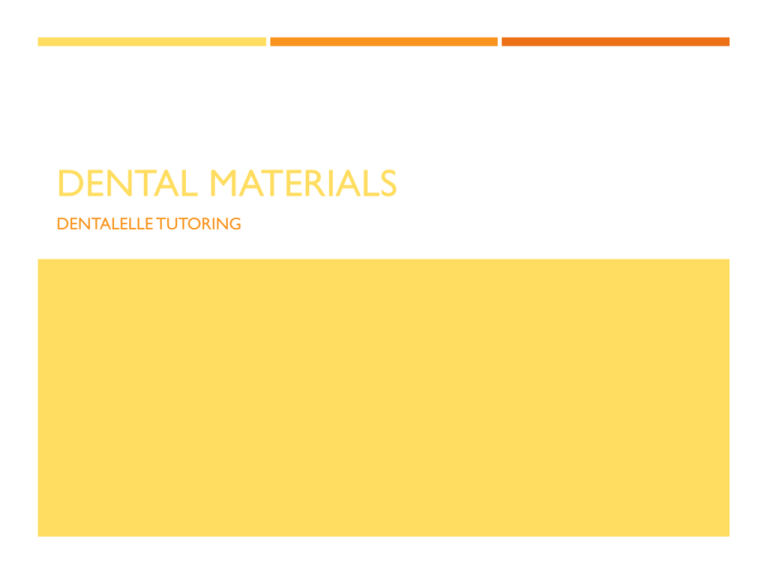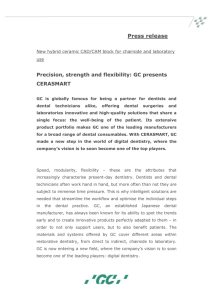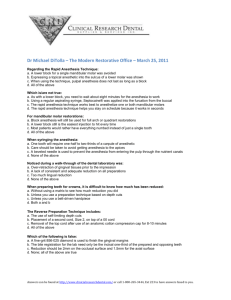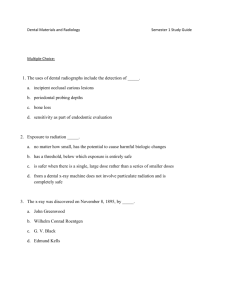Dental Materials Dentalelle
advertisement

DENTAL MATERIALS DENTALELLE TUTORING DIFFERENT MATERIALS Knowing how to manipulate, store, and handle dental materials is critical for chairside assisting. A well-rounded understanding of the choice of material and its use is beneficial for the patient and the operator. The dentist will determine the type of material needed based on the extent of the decay, the condition of the patient’s oral cavity, the location of the dental defect, and the cost factor for the patient. Additionally, each area of dentistry will have its own unique materials that may be used only in that specialty. WWW.DENTALELLE.COM 2 BASES Bases are used just prior to the filling of a prepped tooth to protect the pulp. Dental bases are layers placed under the restoration to protect, insulate, and sedate the pulp. Two of the most popular bases are glass ionomer, and zinc oxide eugenol (ZOE). Glass ionomer is probably the most popular base because of its specialized functions: It releases fluoride ions. It bonds to enamel and dentin. It is radiopaque (blocking radiation, such as from X-rays). It is compatible with all dental restorative materials. Zinc oxide eugenol is sedative (soothing) to the pulp. It insulates the pulp from thermal forces. It protects the pulp. Oil of cloves in the eugenol produces a calming effect on the pulp. It is not compatible under resin-based restorations because the oil of cloves interferes with the bonding of the resin. WWW.DENTALELLE.COM 3 LINERS Dental liners are thin layers that protect the pulp from irritation. One of the most popular liners is calcium hydroxide. Calcium hydroxide is one of the most popular dental liners for the following reasons: It promotes secondary dentin as a measure to protect the pulp. It is placed only on dentin (on the walls and floor of the preparation area). It is compatible with all types of restorative materials. Some brand names include Dycal, Life, and Vitrebond. WWW.DENTALELLE.COM 4 PLACEMENT WWW.DENTALELLE.COM 5 VARNISHES Dental varnish is a type of sealer that seals the dentinal tubules and flows easily but evaporates quickly. It should not be used under glass ionomer or resin restorations.Varnish is always applied after the liner. WWW.DENTALELLE.COM 6 BONDING Restorations can be bonded to both enamel and dentin. Bonding materials prepare the tooth structure to accept a new restoration, sealant, or to bond for various orthodontic procedures. When a tooth is being prepared with the hand piece and bur, the oily layer that the tooth secretes is known as the smear layer. There are numerous techniques and manufacturers of these bonding systems, which are discussed below. WWW.DENTALELLE.COM 7 ACID ETCH An acid etchant, or “conditioner,” uses phosphoric or maleic acid (liquid or gel) to help form a bond between the restoration and the tooth. It can be used on enamel or dentin. Acid etching removes the smear layer just prior to bonding of new restorative material. Phosphoric acid is placed on the tooth structure for 15–20 seconds, then rinsed thoroughly and dried. The tooth structure should appear chalky. This process creates enamel tags that allow the resin-based materials to bond. WWW.DENTALELLE.COM 8 APPLICATION Bonding agents have evolved over the past decade and have revolutionized the application and retention of composite and porcelain materials. The use of bonding creates a micromechanical retention between the restoration and tooth structure. A primer prepares the tooth for the resin materials and can also be a desensitizing agent. An adhesive creates a layer on which to place the resin material. The primer and adhesive can also be applied in one step. However, bonding systems by different manufacturers should not be used interchangeably. Dry field must be maintained via isolation techniques like rubber dam, cotton roll, or dry angle. Self-cure, light-cure, and dual-cure are types of adhesives. WWW.DENTALELLE.COM 9 SEALANTS Dental sealants protect teeth from decay by coating the pits and fissures with resin sealant. Sealants are placed on the occlusal surfaces of posterior teeth. There is a specific order to apply the sealant: coronal polish, cotton roll isolation, acid etch-rinse-dry, then the sealant material is placed and cured. A properly placed sealant should last ten years. Pit and fissure sealants are flowable composite dental materials. WWW.DENTALELLE.COM 10 RESTORATIVE Restorative dental materials can be either permanent or temporary. Once the dental disease is removed from the tooth, the tooth is restored to its functioning state using a restorative material. In addition to restoring function, restoring aesthetics is an important part of the material chosen. Restorative materials can be either direct or indirect. Medicaments are added in a certain order: liner, etch, primer, bond, then composite. WWW.DENTALELLE.COM 11 AMALGAM Traditional amalgam (“silver fillings”) restorations are an example of direct restoration. Amalgams are adhered with chemical bonding or physical retention and used primarily for posterior restorations. The mixing of the mercury and alloy powder that make up the amalgam is known as trituration. The sequence for a Class II amalgam restoration is: prep tooth, place liner or base, place Tofflemire matrix, place amalgam. Instruments are used in a specific order: amalgam carrier, condenser, carver, burnisher, and articulating paper. Amalgam has the following advantages and disadvantages: Amalgam is a mixture of alloy (two or more metals such as silver, tin, copper, and zinc) combined with mercury. Its safety is questioned by some. For example, clinical personnel are cautioned never to touch amalgam with bare hands; to use sufficient ventilation; and to discard it in a closed, covered, impervious container. It must be treated as hazardous waste. WWW.DENTALELLE.COM 12 COMPOSITE Composite or resin restorations are often referred to as “tooth-colored fillings,” and are another example of direct restorations. Composites have gained in popularity due to their esthetics. They can be “bonded” to the enamel and dentin, which actually helps strengthen the remaining tooth structure. The tooth preparation for a composite may be less invasive than an amalgam due to the bonding technique utilized. Glass is added to the composite material for strength. Composite material is layered incrementally and each is light cured in large restorations. (Remember that prolonged exposure to the curing light can damage the retina, so avoid staring directly at it.) Composite restorations have various classes. For example, a Class III restoration would use a mylar strip. Composites are easily polished but not with a low-speed hand piece. Flash refers to excess composite or bond material. A discoid cleoid is never found on a composite tray. WWW.DENTALELLE.COM 13 GLASS IONOMER A third type of direct restoration is glass ionomer. Glass ionomer properties can be altered, which allows them to be formulated as restorations, liners, cements, and bonding agents. When mixing glass ionomer, always follow the manufacturer’s instructions. For example, GC Fuji suggests combining one scoop powder and one drop liquid; mix in one half of the powder for five to ten seconds, and then the second half of the powder for ten to 15 seconds. WWW.DENTALELLE.COM 14 ADVANTAGES OF GLASS IONOMER A glass ionomer has the following advantages: It is very versatile. It can be used for liners, core build-ups, restoratives, and cements. It is aesthetically pleasing. It is anticariogenic (preventing tooth decay by releasing fluoride). It bonds chemically to the enamel and dentin of the teeth. It comes in many shades. It is radiopaque (visible on X-rays), which is a distinct advantage over calcium hydroxide. It is compatible with all dental restorative materials. WWW.DENTALELLE.COM 15 INDIRECT RESTORATIONS Indirect restorations are completed in two or more dental visits, although CEREC (Chairside Economical Restoration of Esthetical Ceramics) units create a porcelain crown in one visit. Other restorations are actually fabricated in the dental lab. These restorations are referred to as cast restorations. Cast restorations are made from impressions taken of the patient’s mouth and then sent to the lab. Sometimes, crowns have to be returned to the lab for perfecting, but not in the case of slightly high occlusion. Examples of indirect restorations are gold crowns, porcelain crowns/porcelain fused to metal crowns, and other indirect restorations (three-quarter crowns, inlays, onlays, and veneers). WWW.DENTALELLE.COM 16 GOLD CROWNS Gold crowns have many advantages. These are used where aesthetics are not the primary concern and if the inter-arch space does not allow sufficient room for porcelain. Also, if the patient clenches or grinds, gold will not suffer fracture strain. Gold crowns have the following qualities: The gold in these crowns is combined with other metals for strength. They resist the harsh environment of the oral cavity. They are available in four types. They are fabricated in the dental lab. They are cemented with permanent cement. They are healthy for the gum tissue. WWW.DENTALELLE.COM 17 PORCELAIN AND PFM Porcelain crowns and porcelain fused to metal crowns are most commonly used in fixed prosthodontics. The versatility of porcelain allows for the following advantages: They are most often used in dentistry. They are aesthetically pleasing. They are fabricated in the dental lab. They are cemented with permanent cement. They match natural surrounding teeth. WWW.DENTALELLE.COM 18 OTHER INDIRECT RESTORATIONS Other indirect restorations include three-quarter crowns, inlays, onlays, and veneers. Inlays are fabricated extraorally and cemented in place. Onlays are similar to inlays, but they must include at least one cusp. For example, a restoration that extends over the cusps of posterior teeth leaving the facial and lingual aspects of the tooth intact is an onlay. These restorations may be made with porcelain or made of full gold. WWW.DENTALELLE.COM 19 STAINLESS STEEL CROWNS Stainless-steel crowns come in a variety of sizes and must be contoured and trimmed to fit the tooth. Adult gingival tissues do not tolerate stainless-steel crowns, which is why they are reserved mainly for use on children. They are utilized as permanent coverage on primary teeth or as temporaries on permanent teeth. Once trimmed, stainless-steel crowns are lined with cement and seated in place. WWW.DENTALELLE.COM 20 RETRACTION CORD During the crown procedure, it is necessary to retract the gingival tissue prior to the final impression. The cord comes in a variety of sizes, the largest of which is size 3. They are utilized for temporary retraction of gingival tissues surrounding a prepped tooth so that an accurate impression of the margin can be attained. They can be braided or unbraided. They can be impregnated with hemostatic solution to control bleeding (epinephrine or vasoconstrictor are not to be used for patients with heart conditions). Some states limit this expanded function to a dental assistant only placing a non- impregnated retraction cord. Other methods, such as foaming agents and adjuncts, are utilized to retract gingival tissue. WWW.DENTALELLE.COM 21 TEMPORARY CROWNS After the tooth has been prepared for a crown or bridge, the tooth needs coverage for comfort, protection, and aesthetic purposes. A provisional, or temporary, crown is prepared and placed for the interim while the final crown is fabricated in the dental laboratory. There are two types of provisional crowns: custom acrylic temporary crowns and preformed temporary crowns. Custom Acrylic Temporary Crowns: These types of crowns can be made from powder and liquid (trim) or from a cartridge that combines a base and a catalyst in a mixing tip. Preformed Temporary Crowns : These types of crowns have a polycarboxylate anterior and an aluminum shell posterior. Celluloid crowns are made of clear plastic material and are primarily used for anterior teeth. WWW.DENTALELLE.COM 22 DENTAL CEMENTS Dental cements are classified according to their properties and, therefore, their uses in dentistry. Type I cements are used for the placement of a restoration for long-term or short-term purposes. Type II are restorative materials. Type III are those materials utilized as bases and liners. Dental cements are either temporary or permanent. WWW.DENTALELLE.COM 23 TEMPORARY CEMENTS Sometimes, there is a need for selecting a dental cement for short-term or sedative purposes. Generally, temporary cements last about six months. The operator will listen to the patient’s chief complaint and choose the cement accordingly. Temporary cements have the following qualities: They are utilized for cementing provisional (temporary) restorations. In some cases, they are utilized for temporarily cementing permanent restorations when the tooth is experiencing symptoms. They can have sedative properties. Follow the manufacturer’s instructions on whether to mix cements on paper or cooled glass, or with an automix extruder. The most commonly used temporary cements are as follows: Temp Bond, which is supplied in two tubes: base and catalyst and ZOE (zinc oxide eugenol), which comes in powder and liquid form. WWW.DENTALELLE.COM 24 PERMANENT CEMENTS When seating a final cast restoration, the luting agent will act as an adhesive to hold the restoration to the tooth structure. Permanent cements are used to attach the permanent crown, which is placed in the patient’s mouth, and he or she is instructed to bite down on an orangewood stick/cotton roll. A crown and bridge cementation tray set-up would include instruments such as a low-speed hand piece, plastic instrument, temporary cement, and cement spatula, but not a gingival margin trimmer. Permanent cements have the following qualities: They are utilized for permanently cementing cast restorations. They are long-lasting. They do not interfere with the proper fit of cast restorations. They can be anticariogenic. Assistants should follow the manufacturer’s instructions on whether to mix cements on paper or cooled glass, or with an automix extruder. WWW.DENTALELLE.COM 25 BRAND NAMES OF PERMANENT CEMENTS Can include: Ketac Cem (glass ionomer), which comes in powder and liquid and/or applicaps Panavia (resin cement), which is light-cured and used for bonding all porcelain restorations Durelon (polycarboxylate), which comes in powder and liquid Fleck’s (zinc phosphate cement), which comes in powder and liquid and is mixed on a glass slab since it has an exothermic reaction WWW.DENTALELLE.COM 26 IMPRESSION MATERIALS Impressions are taken in order to create reproductions of patients’ teeth and tissues. Follow the manufacturer’s instructions on whether to hand-mix these on a paper pad or to automix them in an extruder. When pouring an impression with dental plaster, the material is added slowly, with steady increments from one side of the impression. A positive reproduction of the impression is created in a model. Models may be used for several different purposes, including study models, prosthodontic models, and lab procedure models. There are two types of impression materials: preliminary (alginate), and final. WWW.DENTALELLE.COM 27 ALGINATE Preliminary impressions are used to create study models for “non-permanent” types of appliances. The most common material utilized for a preliminary impression is irreversible hydrocolloid, which is also known as alginate. It may be hand mixed or available for use in the Pentamix system. Preliminary impression materials have the following qualities: They are used for opposing impression during crown and bridge procedure. They are used for fabrication of diagnostic study models, bleach trays, occlusal guards, and some denture procedures. They come in powder and liquid forms. Some brands have automix cartridges. They can be flavored for patient comfort. They come in fast set or regular set. They are inexpensive. WWW.DENTALELLE.COM 28 FINAL IMPRESSION Final impressions must provide an extremely accurate reproduction of the tissues and teeth. The final impression must be taken by the dentist. Final impression materials have the following qualities: They are utilized for master impression of the prepped tooth, and then sent to the lab for fabrication of a cast restoration. They are durable and resist tearing. Elastomeric impression materials are a type of final impression material. WWW.DENTALELLE.COM 29 BRANDS OF IMPRESSION MATERIALS Polyether (Impregum): This is supplied in two tubes: base and catalyst. It is used in a Pentamix machine, which is a newer technology that “automixes” the impression material and dispenses the product much like a soft-serve ice cream machine. It eliminates the risk of improper mixing technique or exceeding the mixing time. Polysulfide (Coe Flex): This is supplied in two tubes: base and catalyst. Polyvinyl Siloxane (Extrude and Express): This uses a two-gun or a putty-wash technique. Bite Registration: This technique is utilized for making a replica of the relationship of maxillary arch to the mandibular arch. It is sent to the lab with the final impression and opposing impression. Polyvinyl Siloxane bite registration material is used. It is supplied in a paste or cartridge system. This method is very accurate and is still used today. WWW.DENTALELLE.COM 30 IMPRESSION MATERIALS WWW.DENTALELLE.COM 31 TRAYS Impression materials must be delivered into the oral cavity utilizing an impression tray. Medium- or heavy bodied impression material is known as tray material. Depending on the impression material or the area to be duplicated, the assistant and operator have several choices of the tray type selected: traditional metal trays, disposable trays, triple trays, or custom acrylic trays. WWW.DENTALELLE.COM 32 DIFFERENT TYPES Traditional Metal Trays - come in perforated or solid, full arches or quadrant. They are autoclaved and reused. They are usually reserved for use with alginate. Disposable Trays - come in perforated or solid, full arches or quadrant. These trays are single-use only. Usually, a tray adhesive is used. Triple Trays - are used only for final impressions and bite registrations. They are used as a time-saving technique by taking the final impression and bite registration at the same time. Custom Acrylic Trays - are made especially for the patient’s arch. These trays are commonly used in prosthetic procedures. WWW.DENTALELLE.COM 33 LAB MATERIALS The gypsum product selected for the reproduction of dental models depends on the purpose of the model use. Dental laboratories tend to use stronger materials, while dental offices will use plaster and orthodontic stone for their purposes. There are several types of laboratory materials: plaster (model plaster), stone, and high-strength stone (die stone). WWW.DENTALELLE.COM 34 TYPES Plaster (Model Plaster) Plaster or model plaster is used for making diagnostic casts and pouring preliminary impressions. Stone Stone is used when a stronger model is needed or for working models for dentures, night guards, bleaching trays, surgical stents, and so on. High-Strength Stone (Die Stone) High-strength stone or die stone is utilized by dental lab technicians for fabrication of cast restorations. It is the strongest stone. WWW.DENTALELLE.COM 35 LAB EQUIPMENT Lathe A lathe is used for polishing temporary crowns or casting gold restorations. Model Trimmer A model trimmer is used for trimming models when separated from impression materials. WWW.DENTALELLE.COM 36 Vacuum Former A vacuum former is used for the fabrication of bleach trays. WWW.DENTALELLE.COM 37 Vibrator A vibrator is used to help eliminate air bubbles in freshly mixed plaster or stone. WWW.DENTALELLE.COM 38 Waxes Waxes are used for bite registration, customizing impression trays, wax rims, wax-up models, sticky wax, and so on. Laboratory Instrumentation Instruments used in a dental lab include lab knives, spatulas, mixing bowls, mixing pads, glass slabs, rag wheels, buffers, sand blasters, polishing discs, and so on. WWW.DENTALELLE.COM 39 OTHER MATERIALS In root canal therapy (RCT), the filling material placed in the canals is gutta percha, which is a type of rubber from the Palaquium gutta tree of Malaysia. Periodontal dressings are used to cover and protect a surgical site while the tissue heals. They are supplied as a light-cured material, a eugenol-based material, and as a non-eugenol-based material. WWW.DENTALELLE.COM 40




